All India Coordinated Research Project (Tropical Fruits) on Citrus, Dr. P.D.K. V., Akola
|
|
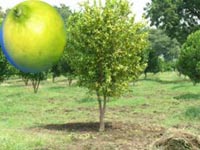 |
||
|
|
Faculty Information |
||
|
|
|||
|
|
|||
|
|
|||
|
|
|||
|
|
|||
|
|
|||
|
|
About Project
Indian Council of Agricultural Research (ICAR) started All India Coordinated Research project for Tropical fruits on Citrus under Five year plant vide letter No. 29.1.1974. BMC dated 30.7.75 and started functioning from November; 1975.The unique feature of this project was its reliance on multidisciplinary research approach in identifying constraints and providing viable solutions citrus growing area of Vidarbha region. The project presently has Cooperative centers, Akola center is one of them.
Agro Climatic Information
| Location | : | National Highway No. 6 on Akola- Nagpur Road |
| Latitude | : | 22041.642’ N |
| Longitude | : | 7700.1722’ E |
| Altitude | : | 307.42 m |
| Soil Type | : | Light – Medium black (Inceptisol / Vertisol) |
| Climate | : | Sub-tropical |
| Temperature | : | 29.0 – 42.70C (Maximum), 10.3- 27.60C (Minimum) |
| Rainfall (annual) | : | 824 mm |
Infrastructure Facilities
The citrus plantation of Nagpur mandarin and Acid lime was raised on twelve hectare area at Central Research Station, Dr. PDKV, Akola started from 1978. About 2000 plants of Nagpur mandarin were planted in 1978-79 and 500 plants in 1988 including different varieties of mandarin. Acid lime plantation of 200 plants was undertaken in 1978-79 and a plantation of acid lime varieties was done from 1987 having 1000 plants of different varieties.
During the last five years i.e. form 2004 to 2009; different trials on horticultural, entomological and pathological aspects have been carried out as per the technical programme finalized during the biennial group discussion meetings in the last five years.
Mandate
-
To find out causal agents for citrus decline
-
To screen different root stocks for resistance against pest and disease
-
To study viral, fungal pests and nutritional complex.
-
To formulate effective control measures against the factors responsible for citrus die-back
-
To demonstrate package of practices though pilot projects.
-
To prepare virus free planting material.
-
To study the variatal performance of Nagpur mandarin and Acid lime
-
Improvement in Nagpur mandarin and Acid lime by selection
-
Evaluation of root stocks for Nagpur mandarin
-
To study the production technology aspects like spacing, nutrition, irrigation, regulation of flowering and weed control etc.
-
To study the seasonal incidence of various pest and diseases on citrus
Research Activities and Achievements
Varieties released
Orange :
- Nagpur mandarin
- Nagpur seedless
Acid Lime: 1. PDKV lime
Research Recommendations
Horticulture
-
Kinnow mandarin proved to be better introspecting of growth and yield, through the yield level were low. Ambia crop was more predominant than Mrig crop. Aug-Sept. fruit drop was found to be more severe.
-
Taking sun hemp as green manuring crop in kharif season is advantageous. Cowpea as a Rabi intercrop, recorded a profit of Rs. 1020/- per ha, whereas gram has given Rs. 457/- per ha.
-
Mulching in Nagpur santra orchard with wheat/paddy straw about 5 cm. Thick layer was found to conserve about 17.6% more moisture in upper 22cm. Layer of soil mulching with leaves however conserved 12.14% soil moisture.
-
Application of grammoxone @ 1.5 lit/ha followed by application of Diuron @ 1.0kg/ha after 20 days was found to be effective in controlling weeds in Nagpur mandarin orchards.
-
Maximum fruit yield (696fruit/tree) was obtained from the trees receiving 30 kg FYM: 1000g N: 500 g P and 0 g K + Borocol 250 g/tree in Borocol trial.
-
In Nagpur mandarin significantly maximum yield ( Number and weight of fruit) was obtain from the trees receiving 800g N+300 g P+ 600gK + 7.5 kg Neem cake
-
Marmalade orange and rough lemon rootstocks are recommended for Kinnow mandarin, as the trees on these rootstocks produced significantly more yield.
-
For maximum production of Acid lime fruit Sweet lime rootstock is recommended.
-
Soil application of 200 g Znso4 per trees is recommended for Nagpur mandarin as it gave maximum yield ( Numbers and weight of fruits)
-
It is recommended that, the Nagpur mandarin trees growing on medium type of soil (one meter depth) are to be irrigated at 40 per cent soil moisture depletion (coinciding with 60 mm CPE) for getting more yield of quality fruits.
-
Drip method of irrigation (on the basis of CPE) is recommended to Nagpur mandarin trees as the trees on drip method of irrigation produced significantly maximum yield of bigger sized fruits with m9re juice and TSS content and ensured 30 per cent saving of irrigation water over traditional irrigation method.
-
Application of three sprays of Gramoxone 1.8 L/ha + 0.2% Urea at an interval of one month is recommended for controlling the monocot and dicot weeds in Nagpur orchard.
-
It is recommended that, 50 days soil moisture stress is sufficient for Nagpur mandarin trees grown on medium type of soil for obtaining maximum yield of Mrig bahar
-
For regulation of hasta bahar flowering in Acid lime for obtaining mac9mum yield of hasta bahar fruits of acid lime, 30 days soil moisture stress (from 15th September to 15th October)with 50 ppm Ascorbic acid spray ( at the time of release of stress) or 30 days sol moisture stress with de blossoming in preceding season and 10 ppm GA spray ( at the time of release of stress) in medium type of soil is recommended
-
Application of 1200 g N + 400 g p2o5 400 g K2o for fully grown up Nagpur mandarin tree per year is recommended for obtaining maximum fruit yield of superior quality. The fertilizer should be applied in two split up doses, i.e. 600 g N +400 g P2o5 + 400 g K2o at the time of release of water stress before flowering and remaining half dose of N should be applied two month after fruit setting.
-
Application of 600 g N + 600 g P2o5 + 300 g k2o + 7.5 kg Neem cake per tree per year is recommended to Acid lime trees for obtaining maximum fruit yield at superior quality. The fertilizer should be applied in two split up doses, i.e. 300 g N + 30 g p2o5 + 300 g K2o + 7.5 kg Neem cake before flowering and remaining half dose of N should be applied two month after fruit setting.
-
In decline Nagpur mandarin orchard, medium type of pruning consisting removed of terminal shoots up to 45 cm in the month of June is recommended for rejuvenation and maximum yield of superior quality of fruits. Immediately after pruning a recommended dose of fertilizer and spraying of fungicide and insecticide should applied.
-
For Nagpur mandarin plantation 6 x 6 m spacing is recommended in Vidarbha region which is suitable for higher yield with superior quality fruit production.
-
In old declining Acid lime orchard medium type of pruning in first week of June (removal of terminal shoots up to 45 cm) is recommended for maximum yield of superior quality.
-
One spray of Cycocel 1000 ppm is recommended for induction of flowering at the time of starting of water stress to Nagpur mandarin in Mrig bahar.
-
Green gram or Onion seed production is recommended as inter crop in Acid lime orchard.
-
The spraying of GA3 20 ppm or Thiourea 0.1 % four times at monthly interval starting from 45 days after transplanting of Rough lemon rootstock seedlings which were stunted and not up to mark for scion budding in Nagpur mandarin was found effective for vigorous growth of rootstock and scion.
-
It is recommended that, the inter-cropping of cotton should not be taken up in pre bearing mandarin orchard.
-
A spraying of glycel 41 % SL @ 1.00 % + 2.00 % urea (10 ml glycel + 20 g urea per litre of water) was recommended at 25 days after germination of weeds in rainy season for effective weed control in Nagpur mandarin.
-
The spraying of GA3 25 ppm or urea 1% on Rangpur lime seedlings four times at monthly interval starting from 45 days after transplanting was recommended for obtaining the seedling of better vegetative growth and more percentage of seedlings of buddable size.
-
Seventy per cent agro-net is recommended for covering the bud grafts of Nagpur mandarin budded on Jamberi/Rangpur lime rootstock for getting the higher vegetative growth and reducing the mortality of bud grafts. This net should be covered on budding immediately after budding in February till the onset of rain in nursery.
-
The Nagpur mandarin orchard in black cotton soil, where the stress is insufficient due to pre-monsoon rains, the spray of 3000 ppm Cultar in stress condition in the first fortnight of May is recommended for assured flowering, fruit setting and yield of fruits.
-
Application of 450 N + 225 K2o through drip & 300 g P (SSP) through soil application per tree per year is recommended to Acid lime trees for obtaining maximum yield of superior quality fruit
-
Application of 900 gm N, 300 gm P, 30 g K, 50 kg FYM+ 20 gm PSB is recommended for obtaining superior quality fruit of Nagpur mandarin fruit.
-
For saving irrigation water instate of Basin system application of 53.41 lit. water in winter & 101.72 lit water in summer per tree per irrigation through sprinkler is recommended for Nagpur mandarin.
-
For obtaining maximum quality yield of Nagpur mandarin application of 800 g N + 300 g P + 600g K with 7.5 kg neem cake per tree in to two splits is recommended to Nagpur mandarin tree. 400 g N + 300 g P + 600 g k was 7.5 kg Neem cake is applied at the time of vetecte of stress and vomaring 400 kg and after two month of fruit set.
-
Application of 1200 g N + 400 g P2O5 + 400 g K2O for fulley grown up Nagpur mandarin tree per tree is recommended for obtaining maximum trait yield of superior quality the fertilizer should be applied in the split up doses i.e. 600 g N + 400 g P2O5 + 400 g K2O at the time of relate of water stress before flowering and remaining half dose of N should be applied two months after fruit setting.
-
Application of 600 g N + 300 g P2O5 + 300g K2O + 7.5 kg neem cake/tree / hear is recommended to Acid lime trees for obtaining maximum fruit yield of superior quality. The fertilizer should be applied in two split up doses i.e. 300 g N + 300 g P2O5 + 300 g K2O + 7.5 kg Neem cake before flowering and remaining half dose of N should be applied two month after fruit setting.
-
In declining Nagpur mandarin orchard medianum type of pruning consisting removal of feninal shoots upto 45 cm in the month of June is recommended for rejuvenation and maximum yield of superior quality of fruits. Immetiatngs after pruning a recommended close of fertilizer and spraying fo fungicide and insecticide should applied.
-
Based on the varietal performance, among mandarin varieties, Nagpur mandarin is recommended for cultivation in Vidarbha region due to it higher yield of superior quality fruit production.
-
PDKV lime is recommended for release of variety due to its higher yield and superior quality fruit production.
-
6 x 6 m spacing is recommended for Nagpur mandarin plantation in Vidarbha region which is suitable for higher yield with superior quality fruit production
-
In old Acid lime orchard medium type of pruning removal of terminal shoots up to 45 cm. Is recommended for maximum yield of superior quality.
Plant Protection
-
First spray of monocrotophos 0.025% + Neem oil 1.00% followed by second spray of Neem oil 1.25% on each flush are recommended for control of citrus black fly.
-
For control of Phytophthora root rot in nursery use of Rough lemon (Akola) (Jamberi) and Rangpur lime (Akola) rootstocks are recommended.
-
Pruning followed by first spray of Copper oxychloride 0.3%followed by 4 sprays of Streptocycline 100 ppm + Copper oxychloride 0.3% are recommended for reducing Acid lime canker infection on leaves.
-
From the studies conducted as Regional Fruit Research Station, Katol for three years on comparative efficacy of different insecticides for the control of citrus psylla, the following are recommended,
i. Fenvalerate 0.01% or ii. Permethrin 0.01% or
iii Methyldemeton 0.04% or iv Methamedophos 0.05% or
v. Fenthin 0.05% or vi Formothion 0.04% or
vii Vamidothion 0.05% or viii Quinolphos 0.04% or
ix Phosalone 0.05% -
The efficacy of different fungicides alone and in combination with insecticides to control sooty mould on citrus, it was recommended that diamethoate 0.1% alone may be used for effective control of the mould development without addition of fungicides.
-
Morocide 0.02% or wettable sulphur 0.5% were recommended against, control of mites.
-
The newly tested insecticides i.e. Phosalone 0.025%, Quinolphos 0.025%, Acephate 0.05% and Mecarban 0.05% were found effective against first instar nymphal stage.
-
For the control of early nymphal population of citrus black fly, Azadirachtin 1500 ppm after fifty percent hatching of eggs and second spray 15 days thereafter is recommended.
-
For the management of nymphal population of citrus black fly, two releases of 4 to 6 eggs of Mallada boninensis /shoot during hasta bahar is recommended.
-
For the control of citrus leaf eating caterpillar, spray of Fenvalerate 0.01% or Acephate 0.05% or Quinolphos 0.05% or Monocrotophos 0.04% after the incidence of the pest was recommended.
-
For control of bark eating caterpillar on citrus, spot application of DDVP 0.05% on the affected trees or application of petrol swab in larval holes are recommended during the month of October-November.
-
Drenching of Ridomil MZ-72 @ 0.2% during August, December and June coupled with spraying of copper oxychloride @ 0.3% during October and April after transplanting of Jamberi seedlings is recommended to control the mortality of Jamberi seedlings before and after budding.
-
For control of citrus diseases and annual weeds soil solarization for 45 days during September to November, using clear transparent polythene sheet was recommended. Seeds treatment with Thirum + Captan 3 g per Kg of seed (1:1)
-
For control of Jamberi seedling mortality in secondary nursery, soil solarization for 45 days during May and June with drenching of Metalaxyl MZ 0.2% during August, December and June and spraying of Metalaxyl MZ 0.2% during October, February and April is recommended.
-
Application of Metalaxyl MZ 50 g per litre or Alliete 50 g per litre stem pasting at initiation of disease and second after 30 days from initiation of the disease for effective management of gummosis of Nagpur mandarin is recommended.
-
Neem oil 1% may be recommended for the control of black fly nymphs on citrus. Teepol or detergent washing powder should be used as emulsifier for preparing spray liquid of Neem oil (1:10)
-
Mean survival rate of the generation of black fly in terms of reproduction females responsible for causing further infestation were worked out for different seasons. It was found to be maximum during hasta flush brood(9.37%) following by Ambia flush brood (6.16%) and least during Mrig brood flush (5.67%)
-
The maximum reductions of black fly nymphs in all the three Neem products, Neem seed extract 5%, Neem leaves extract 5% Neem oil 1% indicated their effectiveness in controlling black fly nymph. Among these products, Neem oil 1% (emulsified ) was superior followed by Neem seed kernel extract 5% and Neem leaves extract 5.0%
-
For management of citrus leaf minor it is recommended to spray Malathion 0.07% or Neem oil 1% at the time of initiation of the pest incidence.
-
For control of citrus leaf eating caterpillar spraying of Fenvalerate 0.01% or Monocrotophos 0.04% or Acephate 0.05% is recommended.
-
For control of citrus black fly in the 1st and 2nd nymphal stage, spraying of Acephate 0.05% is recommended.
-
For the control of fruit sucking moth spraying of Neem seed extract 5 % or fish oil rosin soap 2% or Karanj oil 1% or Azadirachtin 1500ppm or Neem oil 1% are recommended.
-
For control of citrus blackfly in the 1st/ 2nd nymphal stage, spraying of Acephate 0.05%, or Endosulphon 0.05% or Karanj oil 1.0% are recommended in addition to earlier recommendation. For emulsification of Karanj oil in water Teepol or detergent powder should be used n ratio of (1:10)
-
For the effective management of citrus bark eating caterpillar spot application of the solution of DDVP 76 EC @ 0.05% (7 ml10 liters of water) in the bore made by the caterpillar and closing it with mud is recommended.
-
For reduction of Nagpur mandarin Ambia bahar fungal fruit drop, three sprays of copper oxychloride 0.3% or Carbendazim 0.1% at monthly interval stating from July are recommended.
-
For control of citrus leaf eating caterpillar spraying of fenvalerate 0.01% or monocrotophos 0.04% or acephate 0.05% is recommended.
-
For the management of citrus leaf miner it is recommended to spray malathion 0.07% or Achook 1.0% or Neem oil 1.0% immediately after initiation of pest.
-
Citrus pest calender are prepared for the management of citrus pest occurring throughout the year.
-
For the effective management of citrus fruit sucking moth the spraying of neem seed extract 5% or neem oil 1% or Acadiracthtin. 1500 ppm (2 ml/lit) is recommended
-
For the effective management of citrus bark eating caterpillar spot application of the emulsion of DDVP 76 EC @ 0.05% (7 ml/10 lit. of water ) in the bore made by the caterpillar and closing it with mud is recommended.
-
A details study on the seasonal incidence of citrus black fly was undertaken in Katol area which clearly showed that more than 50% eggs was hatched in first fort night of April, in the second fortnight of July and in the first fortnight of December corresponding to Ambia, Mrig and Hasta bahar. The most vulnerable stage was early nymphal population after hatching within a period of 2-3 weeks for appropriate and effective control measures
-
For the control of early nymphal population of citrus black fly, Azadirachtin 1500 ppm after fifty percent hatching of eggs and second spray 15 days thereafter is recommended.
-
For the management of nymphal population of citrus black fly, two releases of 4 to 6 eggs of Mallada boninensis /shoot during hasta bahar is recommended.
Diseases Management
-
Pruning followed by first spray of copper oxychloride 0.3% followed by four sprays of streptocycline 100 ppm + copper oxychloride 0.3% at an monthly interval starting from July, August, September and February are recommended for reducing acid lime canker infection.
-
For control of Phytophthora root rot in nursery use of Rough lemon (Akola) and Rangpur lime (Akola) root stock are recommended.
-
For control of citrus diseases and annual weeds in nursery, soil solarization for 45 days during September to November using clear transparent polythene sheet was recommended. In such seedbed, seed should treated with thiram+ captan 3gm / kg of seed (1:1)
-
For control of rootstock seedling mortality in secondary nursery, soil solarization for 45 days during May and June with drenching of Metalaxyl MZ 0.2 % during August, December and June and spraying of Metalaxyl MZ 0.2% during October, February and April is recommended.
-
Pasting of Metalaxyl MZ 50g or Alliete 50g per liter of water at initiation of disease and second after 30 days is recommended for effective management gummosis in Nagpur Mandarin
-
For reduction of Nagpur Mandarin Ambia bahar fungal fruit drop, three spray of copper oxychloride 0.3 per cent or carbendazim 0.1 per cent at monthly interval starting from July are recommended.
-
In greenhouse study the bioagent Pseudomonas fluorescens was found more effective than Trichoderma viride against Phytophthora root rot
-
The aqueous extract of tagetis leaves and culture filtrate of Aspergillus niger were found effective against citrus canker bacteria.
-
The CTV infection was found more in sweet orange than Nagpur mandarin. Samples indexed from 1997 to 2006 indicates that 22.18% and 1.23% sample showed CTV infection in sweet orange than Nagpur mandarin respectively.
-
In survey, new diseases like sudden gumming followed by splitting of bark and drying of acid lime branches was noticed at some locations.
-
Blackening of inner portion of Nagpur mandarin fruits was observed in some orchards during survey.
Transfer of Technology
Management of Phytophthora Root Rot Infected Plants in Citrus
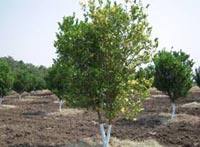 |
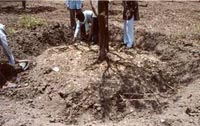 |
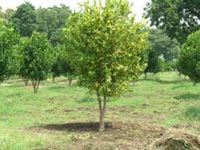 |
Recommendations
-
Removal of all fruits from infected plants
-
Pruning of dried branches along with 5 cm healthy portion of branches.
-
Pruning of shoots 30-45 cm from top.
-
Spraying of 0.1% carbendazim on pruned plants, 4 to 5 lit. Solution should be applied per plant.
-
Exposure of active root zone and pruning of rotten roots.
-
Exposure of active root zone to sunlight for 3-4 days.
-
Drenching 0.2% Metalaxyl MZ in the active root zone (10-20 lit solution/ plant depending upon age of the plants)
-
Prepare the mixture of well rotten FYM 50 kg + 7.5 kg neem cake + 1 kg of ammonium sulphate + 1 kg single super phosphate + ½ kg murate of potash and keep this mixture 5-6 days and then apply in the active root zone and cover with soil and give the light irrigation.
-
One month after fertilization, spraying and drenching of 0.6% Bordeaux mixture.
-
Application of Bordeaux paste (1:1:10) or Metalaxyl MZ or Fosetyl –AL 50 gm / lit of water on tree trunk twice in year i.e. pre and post monsoon.
-
Create the drainage channel in between two rows having the dimension 60 cm width and 30 cm deep for removal of excess water
Fhasta Bahar Management in Acid Lime
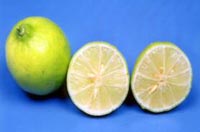
Recommendations
-
Mrig bahar’s fruit should be thinned.
-
Water stress should be given during 15 September to 15 October
-
If rains during stress period, Application of 50 ppm ascorbic acid
-
Application of 1000 ppm Cycocil in August and September.
-
After stress period application 300 g N,300 g P and 300 g K
-
Remaining 300g N after 15 November
-
Light irrigation after breaking stress period
-
Application of Neem cake 7.5 kg/plant
Contact Information
Sr. Horticulturist
All India Coordinated Research Project (Tropical Fruits) on Citrus
Dr. Panjabrao Deshmukh Krishi Vidyapeeth
Akola -444104 (Maharashtra)
Phone : (91) – (0724) 2258200 Ext – 1049






 Krishikosh Repository
Krishikosh Repository


